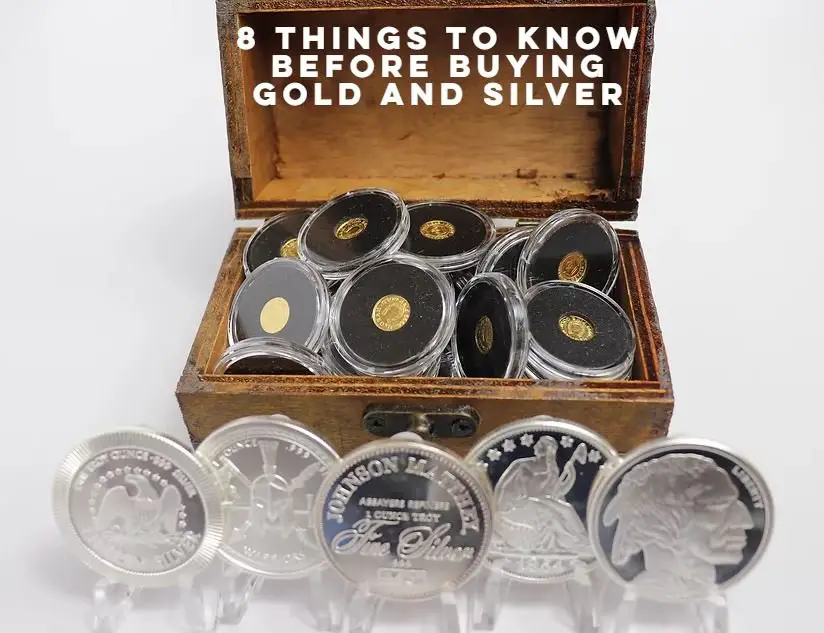Investing in silver and gold is a smart move for those looking to diversify their portfolio and safeguard their assets against economic uncertainties. Wondering what to know about investing in silver and gold? Look no further! In this article, we will guide you through the basics and provide valuable insights into the world of precious metals investing. Whether you’re a seasoned investor or just starting out, understanding the key factors that influence silver and gold prices, the various investment options available, and the potential risks and rewards involved is essential. So, let’s delve into the fascinating world of silver and gold investing and discover how you can make the most of these precious metals.
What to Know About Investing in Silver and Gold
Investing in precious metals has always been a popular choice for investors looking to diversify their portfolios and safeguard against economic uncertainties. Among the various options available, silver and gold have stood the test of time as reliable and valuable assets. However, before diving into the world of silver and gold investing, there are several important factors to consider. In this article, we will explore what you need to know about investing in silver and gold, including their unique properties, market dynamics, and different investment options.
The Unique Properties of Silver and Gold
Silver and gold are not just shiny metals – they possess unique properties that make them attractive for investment purposes. Understanding these properties can provide valuable insights into their intrinsic value and potential as financial assets. Here are some key attributes of silver and gold:
- Physical Durability: Both silver and gold are highly resistant to corrosion and tarnish, ensuring their long-term preservation of value.
- Scarcity: Although silver and gold are finite resources, gold is considerably rarer than silver. This scarcity adds to their allure and contributes to their value.
- Perceived Value: Silver and gold have been valued by civilizations throughout history, which has ingrained their significance in cultures worldwide.
- Industrial Demand: Apart from their monetary value, silver and gold also have numerous industrial applications, making them valuable commodities in various industries.
Understanding Market Dynamics
Investing in silver and gold requires an understanding of the market dynamics that influence their prices. Several factors can impact the value of these precious metals, including:
- Supply and Demand: Like any market, the prices of silver and gold are influenced by supply and demand dynamics. When demand outweighs supply, prices tend to rise, and vice versa.
- Economic Conditions: Economic factors such as inflation, interest rates, and geopolitical uncertainties can significantly impact the prices of silver and gold. These metals often serve as safe-haven assets during times of economic turmoil.
- Currency Fluctuations: As silver and gold are priced in various currencies, fluctuations in currency exchange rates can affect their prices. A weaker currency usually leads to higher metal prices.
- Market Sentiment: Investor sentiment and market speculation also play a role in determining the prices of silver and gold. Positive sentiment can drive prices higher, while negative sentiment can lead to decreases.
Investment Options in Silver and Gold
When it comes to investing in silver and gold, there are several options available to suit different investment preferences and objectives. Some common investment options include:
1. Physical Bullion
Physical bullion refers to purchasing and owning silver or gold in the form of coins, bars, or rounds. This tangible asset allows investors to directly own the metal and store it securely. Key considerations when investing in physical bullion include:
- Purity and Authenticity: Ensure the bullion is of high purity and comes from reputable sources to avoid counterfeit or low-quality products.
- Storage and Insurance: Secure storage solutions are essential to protect your investment, and insurance can further safeguard against potential losses.
- Purchase Premiums and Selling Costs: When buying and selling physical bullion, there are premiums and costs associated. Be aware of these fees to optimize your investment.
2. Exchange-Traded Funds (ETFs)
Exchange-Traded Funds (ETFs) offer a convenient way to invest in silver and gold without physically owning the metal. These funds hold physical bullion or derivatives tied to the metal’s value. Key considerations when investing in ETFs include:
- Expense Ratios and Fees: ETFs charge expense ratios and other fees that can impact your overall returns. Compare different options to find the most cost-effective choice.
- Liquidity and Trading Volume: A liquid ETF with high trading volumes ensures ease of buying and selling shares, providing flexibility to investors.
- Tracking Methodology: Understand how the ETF tracks the silver or gold price and whether it accurately reflects the metal’s performance.
3. Mining Stocks
Investing in mining stocks involves purchasing shares of companies engaged in silver or gold mining. This indirect exposure to precious metals can offer additional upside potential. Key considerations when investing in mining stocks include:
- Company Analysis: Research and analyze the financial health, mining operations, and growth prospects of the mining company before investing.
- Management Team: Evaluate the management team’s experience and track record in the industry to assess their ability to navigate challenges and deliver results.
- Industry Trends: Stay informed about industry trends, exploration projects, and regulatory changes that may impact mining stocks.
4. Futures and Options
Futures and options contracts allow investors to speculate on the future price of silver or gold without owning the physical metal. These derivative instruments can be complex and carry additional risks. Key considerations when trading futures and options include:
- Understanding Market Dynamics: Familiarize yourself with the intricacies of futures and options trading, including contract specifications, margin requirements, and settlement procedures.
- Risk Management: Develop a clear risk management strategy to protect your investments from potential volatility and unexpected market movements.
- Market Research: Conduct thorough research and analysis to identify price trends, supply and demand factors, and other market indicators that can help inform your trading decisions.
5. Precious Metal IRA
A Precious Metal Individual Retirement Account (IRA) allows investors to hold silver and gold within a tax-advantaged retirement account. This option provides long-term exposure to precious metals while enjoying potential tax benefits. Key considerations when opening a Precious Metal IRA include:
- Custodian Selection: Choose a reputable custodian with experience in handling Precious Metal IRAs and ensure they offer the desired investment options.
- IRA Rules and Regulations: Understand the IRS rules and regulations related to Precious Metal IRAs, including contribution limits, distribution requirements, and tax implications.
- Storage and Administration Fees: Evaluate the fees charged for storage, administration, and other services associated with maintaining a Precious Metal IRA.
Investing in silver and gold can be an effective strategy to preserve wealth and diversify investment portfolios. By understanding the unique properties of these precious metals, the market dynamics that influence their prices, and the various investment options available, investors can make informed decisions to maximize their potential returns. Whether you choose to invest in physical bullion, ETFs, mining stocks, futures and options, or opt for a Precious Metal IRA, it is crucial to conduct thorough research and carefully assess your investment goals and risk tolerance. Remember, seeking professional advice is always advisable when venturing into the world of investing in silver and gold.
14 Years of Buying Gold and Silver – Here's What I've Learned
Frequently Asked Questions
Frequently Asked Questions (FAQs)
What are the benefits of investing in silver and gold?
Investing in silver and gold provides numerous benefits, including protection against inflation, diversification of investment portfolio, a hedge against economic uncertainties, and potential for long-term capital appreciation.
How do I invest in silver and gold?
There are several ways to invest in silver and gold: purchasing physical bullion such as coins or bars, investing in exchange-traded funds (ETFs) backed by precious metals, buying shares of mining companies, or investing in mutual funds or precious metals-focused portfolios.
What factors should I consider before investing in silver and gold?
Before investing in silver and gold, it is crucial to consider factors such as market conditions, your investment goals, risk tolerance, storage options, liquidity, and any potential tax implications. Consulting with a financial advisor can help you make informed decisions.
Can I make regular investments in silver and gold?
Yes, you can make regular investments in silver and gold. This can be done through various channels like setting up automatic purchases of bullion or investing in systematic investment plans (SIPs) offered by certain funds or companies.
What is the difference between investing in silver and gold?
While both silver and gold are precious metals, there are some differences in terms of market dynamics and price movements. Silver is known for its industrial use, which can affect its price volatility compared to gold. Gold, on the other hand, is often considered a store of value and is typically more stable.
How do I store physical silver and gold?
Physical silver and gold can be stored in secure locations such as home safes, safety deposit boxes at banks, or in specialized storage facilities provided by bullion dealers. It is essential to ensure proper security measures to protect your investment.
Are there any risks associated with investing in silver and gold?
Like any investment, investing in silver and gold carries certain risks. These can include price volatility, potential loss of value, liquidity issues during market downturns, and the risk of counterfeit products. It is important to understand and manage these risks before investing.
Is investing in silver and gold suitable for everyone?
Investing in silver and gold may not be suitable for everyone. It is essential to assess your investment goals, risk tolerance, and financial situation before deciding to invest. Consulting with a financial advisor can help determine if it aligns with your overall investment strategy.
Final Thoughts
In conclusion, investing in silver and gold can be a smart strategy for diversifying and protecting your portfolio. Both precious metals have a long history of retaining value and serving as a hedge against inflation and economic uncertainties. When investing in silver and gold, it is important to consider factors such as market trends, supply and demand dynamics, and the overall economic landscape. It is also crucial to research reputable dealers and understand the various forms of investment, including physical bullion, ETFs, and mining stocks. By staying informed and making thoughtful decisions, you can navigate the world of silver and gold investing with confidence.

